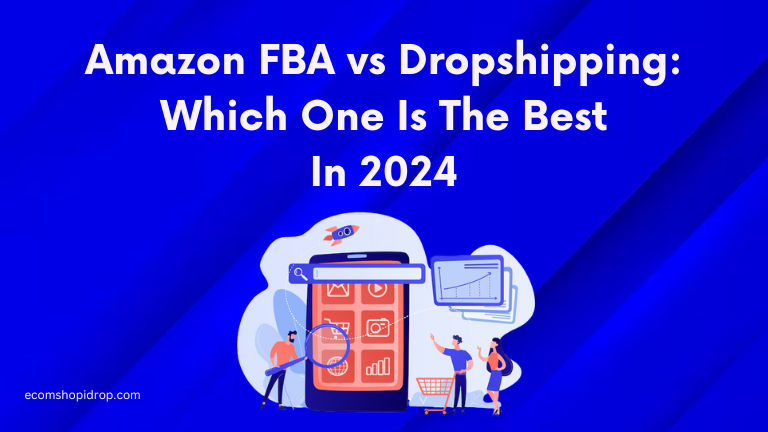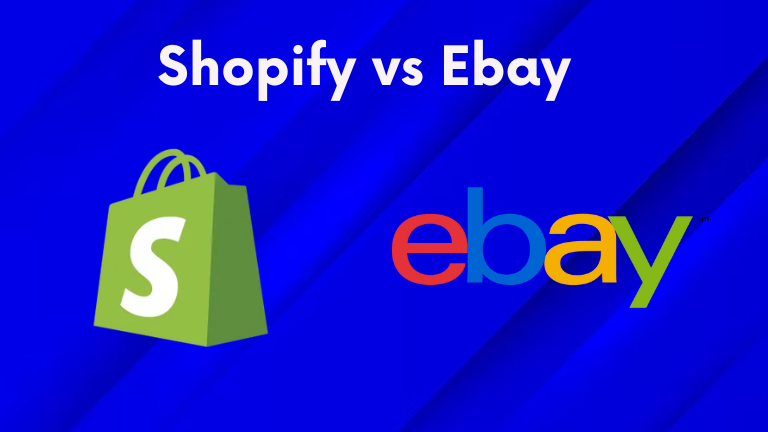
Amazon (FBA) and dropshipping are popular eCommerce business models. choosing the right one between Amazon FBA vs dropshipping can significantly impact the success of your business. Amazon FBA and dropshipping have emerged as popular choices for entrepreneurs looking to start an online business. Both models offer distinct advantages and challenges, catering to different business needs and goals.
Whether you’re considering the reliability of Amazon’s vast fulfillment network or the flexibility of managing a store without inventory, understanding the nuances between Amazon FBA and dropshipping is crucial.
In this comprehensive guide, we explore the differences, pros, and cons of each model to help you decide which method fits best with your business goals for 2024.
What Is the Difference Between Amazon FBA and Dropshipping?
When deciding between Amazon FBA and Dropshipping for your e-commerce business in 2024, it’s crucial to understand the key differences between these two popular business models. Both offer unique advantages and challenges, and choosing the right one depends on your goals, resources, and business strategy.
Amazon FBA (Fulfillment by Amazon) is a service where Amazon handles storage, packing, and shipping of your products. As a seller, you send your inventory to Amazon’s fulfillment centers, and Amazon takes care of the rest. This includes managing customer service and handling returns. Sellers benefit from Amazon’s vast logistics network and Prime shipping capabilities, which can enhance the customer experience and potentially increase sales.
On the other hand, Dropshipping is a retail fulfillment method where the seller doesn’t keep the products in stock. Instead, when a customer places an order, the seller purchases the item from a third-party supplier, who then ships it directly to the customer. This model eliminates the need for inventory management. However, it also means that the seller has less control over the shipping process and product quality.
Key Differences:
Inventory Management:
- Amazon FBA: Requires investment in inventory, which is stored in Amazon’s fulfillment centers.
- Dropshipping: No need to purchase or store inventory, as products are shipped directly from suppliers.
Fulfillment and Shipping:
- Amazon FBA: Amazon handles all aspects of fulfillment, including shipping and customer service.
- Dropshipping: Fulfillment is managed by the supplier, with the seller responsible for any customer service issues.
Startup Costs:
- Amazon FBA: Higher upfront costs due to inventory purchase and storage fees.
- Dropshipping: Lower upfront costs, making it more accessible for beginners.
Control and Branding:
- Amazon FBA: More control over product quality and branding, but within Amazon’s guidelines.
- Dropshipping: Less control over product quality and branding, as these are managed by the supplier.
Profit Margins:
- Amazon FBA: Potential for higher profit margins due to bulk purchasing and Amazon’s trusted platform.
- Dropshipping: Generally lower profit margins, as suppliers often charge higher prices per unit.
By understanding these fundamental differences, you can make a more informed decision about which business model aligns best with your e-commerce goals in 2024.
What Is Amazon FBA
Amazon FBA (Fulfillment by Amazon) is a service provided by Amazon that allows sellers to store their products in Amazon’s fulfillment centers, where Amazon takes care of storage, packaging, and shipping to customers, including handling customer service and processing returns. Sellers create an account on Amazon Seller Central, list their products, prepare and ship them to Amazon’s fulfillment centers, and Amazon stores the products, managing inventory.
When a customer places an order, Amazon picks, packs, and ships the product directly to the customer, also managing customer inquiries, returns, and refunds, leveraging Amazon’s robust customer service infrastructure. Benefits of Amazon FBA include eligibility for Amazon Prime, which can increase sales through fast and free shipping, scalability without logistical challenges, enhanced credibility from Amazon’s trusted platform, and the ability to fulfill orders from other sales channels. However, drawbacks include various fees such as storage and fulfillment fees, inventory management challenges, and intense competition from other sellers and Amazon’s private label products. Understanding these aspects helps sellers decide if Amazon FBA aligns with their business goals and resources.
Pros and Cons of Amazon FBA
Here is some of Pros and Cons For Amazon FBA:
Pros:
- Easy to Start: You only need to follow a few steps. First, create an Amazon FBA account and list your desired products in the FBA inventory. Then, prepare and send your products to Amazon’s fulfillment centers, and let them handle the shipment.
- No Customer Support Needed: Dealing with customers can be time-consuming. The great thing about FBA is that Amazon’s customer service will handle your buyers’ inquiries. Customers can reach Amazon anytime, and there are no additional FBA fees for using this service.
- Scalability: Allows sellers to scale their businesses effortlessly by eliminating the complexities of logistics and fulfillment challenges, enabling them to focus on growth and customer satisfaction.
- Customer Trust: Amazon is a trusted and well-known brand. Using FBA allows you to leverage this trust, as customers are more likely to purchase from a platform they already trust.
- Access to a Global Audience: Amazon FBA helps eCommerce owners scale their businesses by reaching an international audience. For example, the FBA Pan-EU scheme supports fast delivery across European countries. Additionally, you can benefit from FBA Export to expand your online business market to over 100 countries.
Cons:
- Costs: Starting an Amazon FBA business involves various fees that can quickly add up, including storage fees, fulfillment fees, and long-term storage fees. Additionally, there may be costs for shipping, labeling, and other services provided by Amazon.
- High Competition: Since Amazon is one of the most popular selling platforms worldwide, you may encounter other businesses offering similar products at lower prices. It’s important to research and choose high-demand products with low competition. Additionally, competing against more experienced Amazon sellers may require extra effort.
- Restock Limits: Amazon imposes restock limits per storage type, which means you may not be able to send as much inventory as you intend to.
What Is Dropshipping
Dropshipping is a retail fulfillment method that allows sellers to operate without holding inventory. Instead of purchasing products upfront, sellers list items for sale on their online store or marketplace. When a customer places an order, the seller then purchases the product from a third-party supplier, typically a wholesaler or manufacturer, who ships the item directly to the customer. This process eliminates the need for sellers to handle or store inventory themselves, significantly reducing upfront costs and logistical complexities.
In dropshipping, sellers play a crucial role in marketing products, managing customer inquiries, and processing sales transactions. However, they do not handle the physical products they sell, as these are shipped directly from the supplier to the end customer. This model offers several advantages, such as low initial investment requirements, as sellers do not need to purchase inventory upfront. It also provides flexibility in product offerings, as sellers can quickly add or remove products from their online store without worrying about excess inventory.

Despite its benefits, dropshipping comes with challenges. Profit margins can be lower compared to traditional retail models, as suppliers often charge higher prices per unit to cover shipping and handling costs. Sellers also face potential issues with product quality control and shipping times, as they rely on suppliers to fulfill orders promptly and maintain product standards. Furthermore, the dropshipping industry is highly competitive, with low barriers to entry attracting a large number of sellers, leading to price competition and market saturation in some niches.
For entrepreneurs considering dropshipping in 2024, understanding these dynamics is essential for making informed decisions about whether this fulfillment method aligns with their business objectives and operational capabilities.
Bonus: 25 Dropshipping Tips Every Beginner Must Know
Pros and Cons of Dropshipping
Pros:
- Low Startup Costs: It doesn’t require you to manufacture or stock products. This allows you to save significantly on initial investment when starting your eCommerce business.
- No Inventory Management: Dropshipping eliminates the need for storage space and the complexities of inventory tracking. By leveraging third-party suppliers to fulfill orders directly to customers, businesses can focus on sales and customer experience without the overhead of managing physical stock.
- Wide Product Selection: Dropshipping provides access to a vast range of products from various suppliers, offering flexibility in product offerings. This allows businesses to easily expand their catalog without the constraints of maintaining inventory, catering to diverse customer preferences and market demands.
- Location Independence: Dropshipping allows you to operate your business from anywhere, offering the flexibility to work from home, travel, or any location of your choice. This freedom enables entrepreneurs to manage their business seamlessly without being tied to a specific physical location.
Note: Amazon allows sellers to dropship but be sure to follow their dropship policy.
Cons:
- Lower Profit Margins: Dropshipping often involves suppliers charging higher prices per unit, which can reduce overall profit margins for businesses.
- Quality Control: In dropshipping, sellers have limited control over product quality and shipping times. Since products are sourced from third-party suppliers, ensuring consistent quality standards and timely delivery can pose challenges that directly influence customer satisfaction and brand reputation.
Amazon FBA vs Dropshipping : Our verdict
Choosing between Amazon FBA and dropshipping depends on your business goals, resources, and preferences in 2024.
Amazon FBA offers robust logistics support and Prime eligibility, making it ideal for sellers looking to scale with reliable shipping and customer service. It requires higher upfront costs but provides control over inventory and branding within Amazon’s platform.
Dropshipping, on the other hand, appeals to entrepreneurs seeking low startup costs and minimal inventory management. It offers flexibility in product offerings but comes with lower profit margins, potential quality control issues, and competitive challenges.
Conclusion
In conclusion, both Amazon FBA and dropshipping present viable options for e-commerce businesses in 2024, each with its own set of advantages and challenges.
- Choose Amazon FBA if you prioritize scalability, brand control, and leveraging Amazon’s logistics and customer base.
- Opt for Dropshipping if you prefer lower initial investment, flexibility in product offerings, and the ability to operate from anywhere.
Ultimately, the best choice depends on your specific business needs, long-term strategy, and willingness to manage inventory and operational complexities. By carefully evaluating these factors, you can select the fulfillment method that aligns best with your entrepreneurial goals and positions your business for success in the dynamic e-commerce landscape of 2024.
FAQ
Q: Which is cheaper, Amazon FBA or dropshipping?
- A: Dropshipping typically requires lower upfront costs since sellers do not need to purchase inventory. However, Amazon FBA may offer economies of scale and potentially lower shipping costs through Amazon’s fulfillment network.
Q: Can I use both Amazon FBA and dropshipping together?
- A: Yes, some sellers use a hybrid approach where they combine Amazon FBA for certain products and dropshipping for others. This allows them to leverage the strengths of each fulfillment method based on product demand and profitability.
Q: How quickly can I start selling with Amazon FBA or dropshipping?
- A: With dropshipping, you can start selling almost immediately after setting up your online store and connecting with suppliers. Amazon FBA may require more time initially to prepare and send inventory to Amazon’s fulfillment centers.
Q: What are the risks of using dropshipping?
- A: Risks include potential issues with product quality control, longer shipping times from suppliers, and dependency on third-party suppliers for inventory availability and shipping reliability.
Q: How do I choose between Amazon FBA and dropshipping for my business?
- A: Consider factors such as your budget, desired level of control over inventory and branding, scalability goals, and competitive landscape in your chosen niche. Considering these factors will enable you to make a well-informed decision that aligns with your business objectives.



